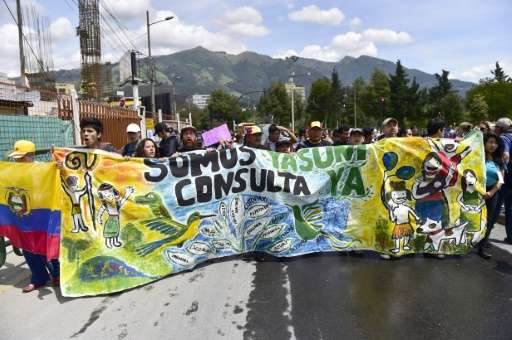The Ecuadorian government defied calls from activists to put the decision to drill inside the Yasuni national park to a referendum
Ecuador began pumping oil Wednesday from a massive field located partly on a protected nature reserve in the Amazon rainforest, drawing criticism from environmentalists and indigenous-rights groups.
After years of fraught debate over whether to drill inside the Yasuni national park, state oil company Petroamazonas started pumping crude from the so-called ITT block, which holds more than 40 percent of the South American country's proven reserves.
"Today, a new era is beginning, a new oil horizon for all Ecuadorans," said Vice President Jorge Glas at a launch ceremony at the Tiputini oil field—which forms the ITT block together with the nearby fields of Tambococha and Ishpingo.
Together, they hold 1.7 billion of OPEC member Ecuador's four billion barrels of proven oil reserves.
President Rafael Correa originally tried to persuade the international community to pay Ecuador $3.6 billion not to exploit the ITT block—an ultimately failed initiative to protect the Amazon and help curb climate change.
But with his government strapped for cash amid a plunge in global oil prices, in the end the leftist leader asked Congress to give the go-ahead to drill, starting with exploration at Tiputini in March.
Next up is Tambococha to the south, in the last quarter of 2016.
The government defied calls from activists to put the decision to a referendum.
Besides being among the most biodiverse areas on Earth, the million-hectare (2.5-million acre) Yasuni park is home to some of the world's last uncontacted indigenous populations.
"The damage is huge," said Esperanza Martinez, head of Ecuadoran environmental group Ecological Action.
She said oil operations on the ITT block risk damaging ecosystems, threatening indigenous groups and installing "oil enclaves" in the region.
The block is not yet operating at full capacity and "already you can see more bars, more brothels, more social problems," she told AFP.
Ecuador plans to ramp up production from the block to 300,000 barrels per day by 2022.
© 2016 AFP
























